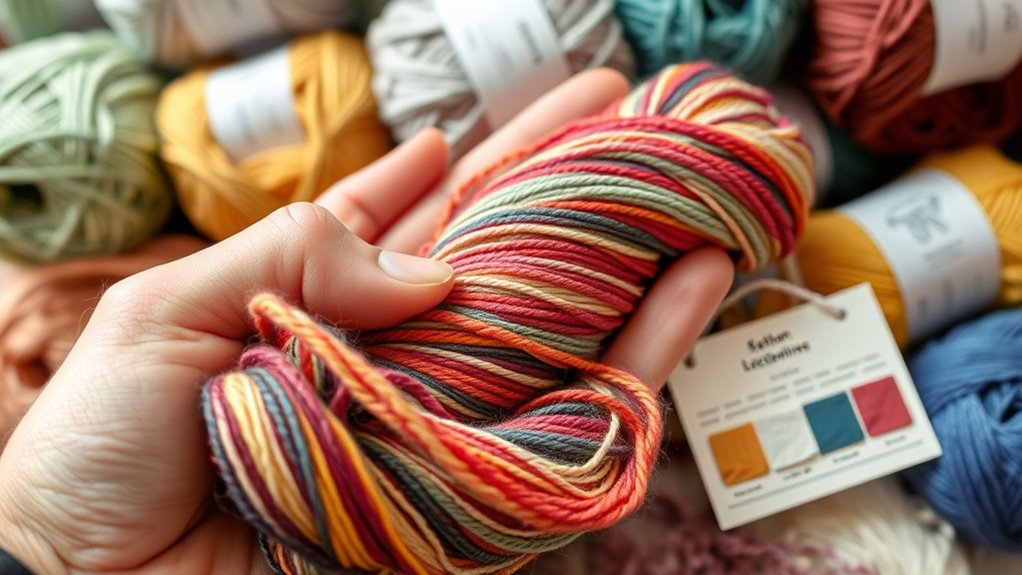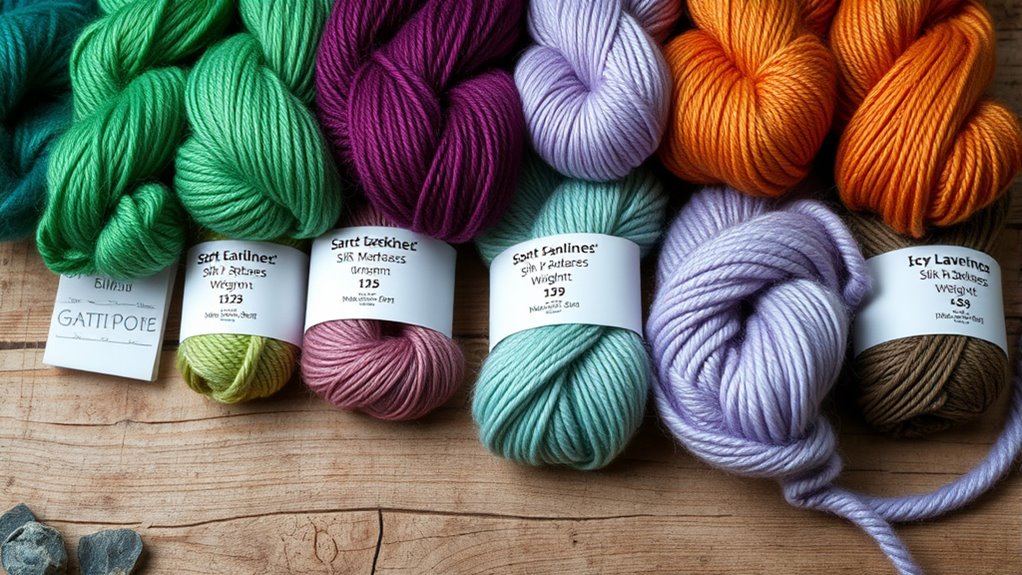To understand yarn weights, fibers, and labels, start by recognizing that different fibers like wool, cotton, and acrylic have unique qualities that affect your project’s look, feel, and durability. Yarn weight refers to thickness, which influences your stitch size and finished size. Labels provide essential info, including fiber content, weight, care instructions, and colorway. Getting familiar with these details helps you choose suitable yarns for your projects, and exploring further will give you the knowledge to craft confidently.
Key Takeaways
- Yarn weight indicates thickness and influences gauge, drape, and project suitability; common categories include lace, fingering, sport, DK, worsted, and bulky.
- Fibers such as wool, cotton, acrylic, and silk have unique properties affecting durability, elasticity, warmth, and care requirements.
- Yarn labels provide essential information like fiber content, weight, yardage, care instructions, and dye lot for proper selection and matching.
- Understanding fiber characteristics helps determine appropriate handling, washing, and maintenance to preserve project quality.
- Organizing yarn by weight, fiber, and colorways enhances project planning, storage efficiency, and overall crafting experience.

Ever wondered how to keep your yarn organized and tangle-free? It’s a common challenge for knitters and crocheters alike. One effective way to manage your stash is by understanding fiber characteristics, which influence not only how your yarn behaves but also how it looks and feels. Different fibers—like wool, cotton, acrylic, or silk—have unique properties that affect the durability, elasticity, and warmth of your finished project. Knowing these traits helps you select the right yarn for your project’s purpose, whether it’s a cozy sweater, delicate lace, or a sturdy bag. Additionally, yarn colorways play a crucial role in your creative process. Yarn colorways refer to the different color patterns and variations within a single skein or ball, such as variegated, striped, or solid hues. Being familiar with these options enables you to plan your project’s color transitions more effectively, avoiding unintended pooling or mismatched shades.
To keep your yarn organized, start by sorting your stash based on fiber characteristics. Group wool, cotton, acrylic, and other fibers separately, as each type may require different handling or storage conditions. For example, wool needs to be kept dry and well-ventilated to prevent moth damage, while acrylic can be stored more casually. Once sorted, consider investing in storage containers or bins that allow you to see your yarn easily. Label each container with the fiber type and the yarn weight, making it quicker to find what you need when inspiration strikes. When it comes to yarn colorways, it helps to organize by color family or by project. For instance, keep all blues and greens together if you’re planning a nature-inspired piece, or group neutrals in one spot for versatile options. Using small zip-lock bags or dedicated compartments can prevent colorway mixes from becoming a tangled mess.
Another tip is to take notes on your yarn’s fiber characteristics and colorways—perhaps in a notebook or digital app—so you remember what works well for different projects. This way, you won’t have to guess when you’re browsing through your stash. Being aware of fiber properties can also help you determine the best cleaning and maintenance routines for your yarn, ensuring its longevity. As you become more familiar with your yarn, you’ll find it easier to match fiber types to project needs and coordinate colorways for cohesive designs. Organizing your yarn this way not only saves time but also keeps your workspace tidy, making your crafting sessions more enjoyable. With a little effort upfront, you’ll enjoy a more efficient and stress-free experience every time you pick up your needles or crochet hook.
Frequently Asked Questions
How Do I Choose the Right Yarn for My Project?
To select the appropriate yarn for your project, consider its purpose and your skill level. If you’re knitting with novelty yarn, pick a pattern that highlights its unique texture. For different projects, choose yarn weight and fiber that suit the item’s use—like soft wool for scarves or durable cotton for dishcloths. Always check labels for fiber content and recommended needle size to guarantee your project turns out just right.
What Are the Environmental Impacts of Different Fibers?
Different fibers have varying environmental impacts. Sustainable fibers like organic cotton, hemp, and bamboo are eco-friendly options because they require less water and pesticides. Synthetic fibers, like polyester, often come from non-renewable resources and shed microplastics, harming ecosystems. When choosing yarn, look for labels indicating eco-friendly production or certifications. By selecting sustainable fibers, you help reduce pollution and conserve resources, making your projects more environmentally responsible.
Can Yarn Labels Be Trusted for Accurate Fiber Content?
You might think yarn labels are foolproof, but fiber content verification isn’t always spot-on. While labels aim for accuracy, label accuracy concerns persist because manufacturers can sometimes mislabel fibers, whether intentionally or not. So, don’t blindly trust the label—inspect, test, or research if you need to be certain about fiber content. After all, a label’s honesty isn’t always the truth, and skepticism can save you from surprises.
How Do I Store Yarn to Prevent Damage?
To prevent fiber damage, you should store your yarn in a cool, dry place away from direct sunlight. Use breathable storage solutions like cotton bags or bins to protect against moisture and pests. Keep your yarn neatly wound or in labeled containers to avoid tangling. Regularly check your yarn for signs of damage or pests, ensuring your fibers stay in great condition for your projects.
Are There Allergy Concerns With Certain Fiber Types?
You should be aware of fiber allergy risks when choosing yarn, especially if you have sensitive skin or allergies. Some fibers, like wool or alpaca, may trigger reactions, so consider hypoallergenic fiber options such as cotton, bamboo, or acrylic. Always test a small piece before extensive use, and check labels carefully to avoid fibers that could cause irritation. Being cautious helps you enjoy knitting without allergy concerns.
Conclusion
Now that you understand yarn weights, fibers, and labels, you’re ready to navigate any knitting or crochet project like a seasoned sailor steering through calm waters. Remember, choosing the right yarn is the compass that guides your creativity and guarantees your masterpiece turns out just as you envision. So, trust your newfound knowledge, experiment boldly, and let your yarns weave stories as vibrant as your imagination. Happy crafting!









